Courses
Fire Safety (Part B Buildings Other than Dwelling Houses, and FSC)
Certificate
Course Details
| Course Code | GA_EFSOG_N09 |
|---|---|
| Level | 9 |
| Duration | 1 semester |
| Credits | 10 |
| Method of Delivery | Blended |
| Campus Locations | Galway City – Dublin Road |
| Mode of Delivery | Part Time |
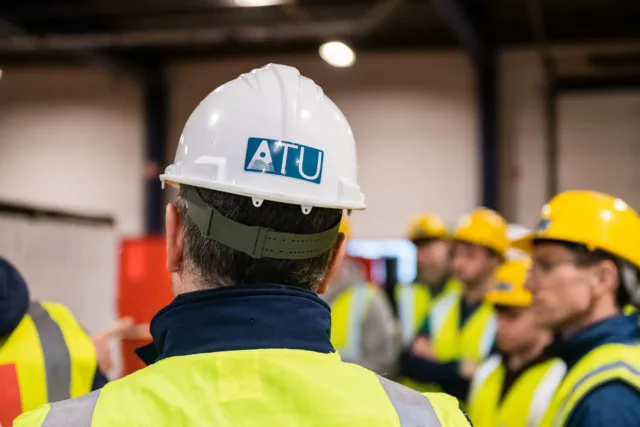
Course Overview
This module aims, in as reasonably practicable a way as possible, to develop an in-depth knowledge, understanding and experience of the design and compliance requirements for Part B Buildings other than Dwelling Houses. The relevant sections of the key codes of practice prima facia linked to this guidance will also be studied. On completion of this module, learners should be able to demonstrate, to a high standard of competence, their understanding and application of Part B through both assessment and project work. Learners should also be able to demonstrate compliance with the fire sections of the building regulations, including the preparation of a Fire Safety Certificate Application.
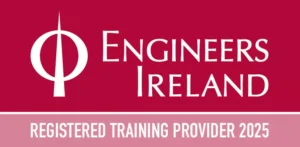
Course Details
Year 1
| Semester | Module Details | Credits | Mandatory / Elective |
|---|---|---|---|
| 1 |
Fire Safety (Part B Buildings Other than Dwelling Houses, and FSC)This module aims to develop an in-depth knowledge, understanding and experience of the design and compliance requirements for Part B Buildings other than Dwelling Houses. On completion of this module, learners should be able to demonstrate their understanding and application of Part B and should also be able to demonstrate compliance with the fire sections of the building regulations, including the preparation of a Fire Safety Certificate Application. Learning Outcomes 1. Investigate, determine and inform their knowledge, skills and experience relating toPart B, B1 Means of escape in case of fire (including an overview of commercial stairs TGD K, B, M), Health and Safety and best practice requirements in the Irish built environment, in a reasonably practicable way. 2. Investigate, determine and inform their knowledge, skills and experience relating toPart B, B2Internal fire spread (Linings), Health and Safety and best practice requirements in the Irish built environment, in a reasonably practicable way. 3. Investigate, determine and inform their knowledge, skills and experience relating toPart B,B3 Internal fire spread (Structure),Health and Safety and best practice requirements in the Irish built environment, in a reasonably practicable way. 4. Investigate, determine and inform their knowledge, skills and experience relating toPart B,B4External fire spread,Health and Safety and best practice requirements in the Irish built environment, in a reasonably practicable way. 5. Investigate, determine and inform their knowledge, skills and experience relating toPart B,B5 Access and facilities for the fire service,Health and Safety and best practice requirements in the Irish built environment, in a reasonably practicable way. 6. Investigate, determine and inform their knowledge, skills and experience relating to the application ofand submission thereafter ofaFire Safety Certificate for a building other than a dwelling. |
10 | Mandatory |
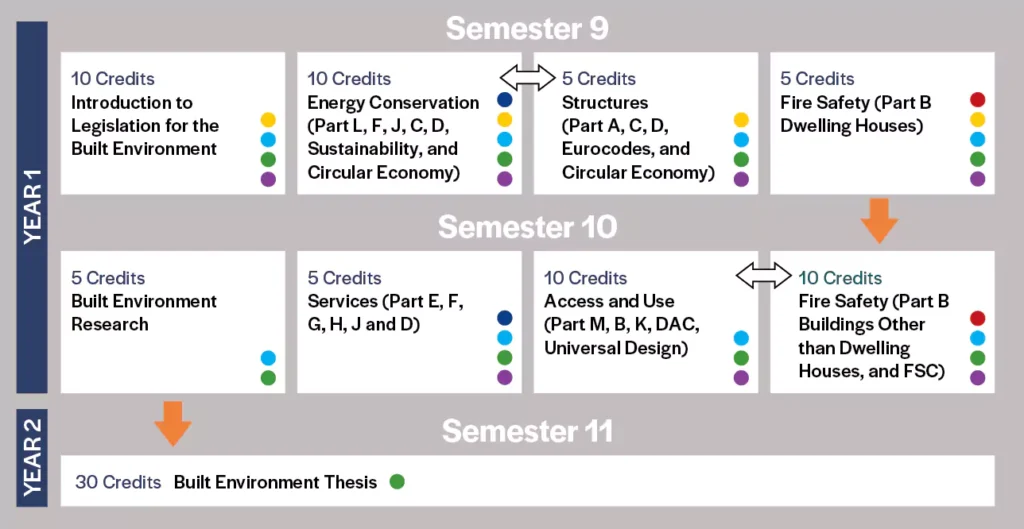
Image description: This is an image of the full time (18 months) MSc Built Environment Regulation learning pathway for a September cohort of students. It uses the identifying colours from the legend to outline the full-time learning pathway on this course for 12 embedded programmes including 7 micro-credentials. Year 1 Semester 9 contains four modules as follows: Introduction to Legislation for the Built Environment (10 credits); Energy Conservation (Part L, F, J, C, D, Sustainability, and Circular Economy) (10 credits); Structures (Part A, C, D, Eurocodes, and Circular Economy) (5 credits); Fire Safety (Part B Dwelling Houses) (5 credits). Year 1 Semester 10 contains four modules as follows: Built Environment Research (5 credits); Services (Part E, F, G, H, J and D) (5 credits); Access and Use (Part M, B, J, DAC, Universal Design) (10 credits); Fire Safety (Part B Buildings other than Dwelling Houses, and FSC) (10 credits). Year 2 Semester 11 contains one module as follows: Built Environment Thesis (30 credits).
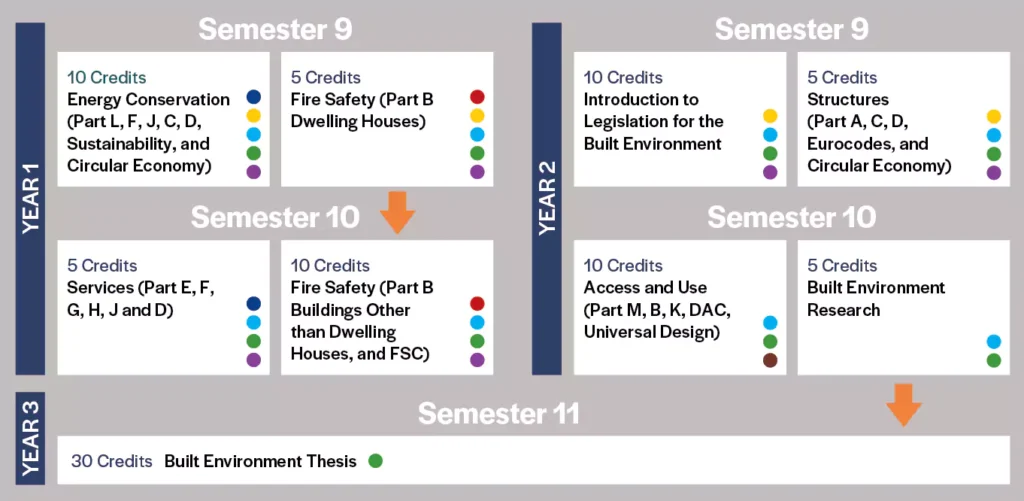
Image description: This is an image of the part time (30 months) MSc Built Environment Regulation learning pathway for a September cohort of students. It uses the identifying colours from the legend to outline the part-time learning pathway on this course for 12 embedded programmes including 7 micro-credentials. Year 1 Semester 9 contains two modules as follows: Energy Conservation (Part L, F, J, C, D, Sustainability, and Circular Economy) (10 credits); Fire Safety (Part B Dwelling Houses) (5 credits). Year 1 Semester 10 contains two modules as follows: Services (Part E, F, G, H, J and D) (5 credits); Fire Safety (Part B Buildings other than Dwelling Houses, and FSC) (10 credits). Year 2 Semester 9 contains two modules as follows: Introduction to Legislation for the Built Environment (10 credits); Structures (Part A, C, D, Eurocodes, and Circular Economy) (5 credits). Year 2 Semester 10 contains two modules as follows: Built Environment Research (5 credits); Access and Use (Part M, B, J, DAC, Universal Design) (10 credits). Year 3 Semester 11 contains one module as follows: Built Environment Thesis (30 credits).
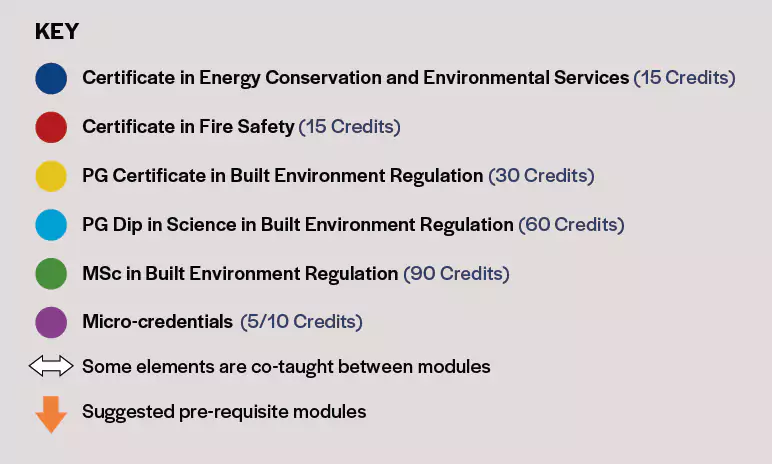
Image description: This is an image of a legend identifying in different colours the 12 programme learning pathways on the MSc Built Environment Regulation. It identifies the following courses: Certificate in Energy Conservation and Environmental Services (15 Credits); Certificate in Fire Safety (15 Credits); PG Certificate in Built Environment Regulation (30 Credits); PG Dip in Science in Built Environment Regulation (60 Credits); MSc in Built Environment Regulation (90 Credits); Micro-credentials (5/10 Credits). It also indicates where some elements are taught between modules and suggested pre-requisite modules.
Recommended Study Hours per week
Examination and Assessment
On-Campus Attendance Requirement
Progression
Successful candidates can progress to any of the following programmes:
- Postgraduate Certificate in Built Environment Regulation (30 ECTS credits) (Minor award)
Postgraduate Diploma in Built Environment Regulation (60 ECTS credits) (Major award)
MSc in Built Environment Regulation (90 ECTS credits) (Major award)
Download a prospectus
Entry Requirements
Candidates must hold a cognate level 8 Bachelor (Hons) degree with a minimum grade classification of H2.2 or equivalent. Candidates who do not meet the H2.2 performance standard in a Level 8 award will be required to pass a qualifying assignment at a H2.2 performance standard as established by the Programme Board for the programme in question and as approved by the Registrar.
English Language Requirements are as determined by ATU and as published in the Access, Transfer and Progression code.
Recognition of Prior Learning (RPL) may be used to gain access to a programme subject to available places.
Careers
This programme may facilitate employment opportunities in the broad area of Building Regulations and Building Control in the private and public sector, in local authority, and on site in the construction sector. This qualification may help to meet annual Continuing Professional Development requirements, and to align with professional body requirements. It may also present opportunities for progression into management and to more senior positions.
Further Information
Application Closing Date
Start Date
Who Should Apply?
There are employment opportunities for building regulation practitioners as specialists within their broader discipline areas of Architecture, Architectural Technology, Building Surveying, Consultancy, Consultant Engineering, Civil Engineering, Building Engineering, Building Services Engineering, Quality Engineering, Building Control Engineering, Local Authority Engineering, and Construction Management, to name a few.
Contact Information
Online, Flexible and Professional Development, Galway-Mayo
T:+353 91 753 161
E: learn.galwaymayo@atu.ie
Department of Building and Civil Engineering
Dr Irene Hayden, Lecturer
T:+353 91 742 109
E: irene.hayden@atu.ie
Online Student Advisor
Eileen O’Hara
T:+353 91 742274
E: eileen.ohara@atu.ie
Building & Civil Engineering


